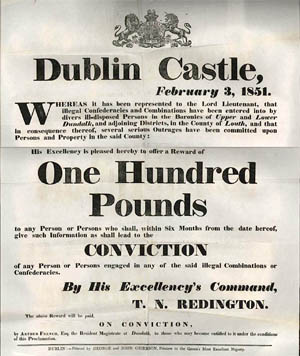KINDRED LINES: OUTRAGE REPORTS
Published in Features, Issue 6 (November/December 2022), Volume 30By Fiona Fitzsimons
Early in the morning of 14 January 1843, the island residents of Lough Ree returned home from the wake of their neighbour Betty Martin. Thady Shea, his adult sons, Bryan and Pat, and their friend John Lally went to the house of Michael Killian on Inchenagh Island. Killian worked the malt kiln that supplied grain for the local whiskey still. At about daybreak (8am) they saw the Revenue Police arrive to raid the island. Bryan Shea left to get help. The police questioned the men. They turned over Killian’s farm, where they found ‘hundreds [of] barrels of malt’.
As news of the raid began to spread, local men, some of them armed, set sail for Inchenagh. Bryan Shea returned to the island with his brother Michael. They found the police loading the bootleg whiskey onto their boats. As Michael Shea disembarked, he called out to the police, ‘Do not shoot any man’. Lt. Horatio Roberts shouted ‘Keep off’, and took aim. Michael Shea, holding ‘an oar in his right hand’ but otherwise unarmed, was shot dead. In the ensuing shoot-out, several people were wounded and Lt. Roberts was blinded in one eye; the Revenue Police seized 800 barrels of malt whiskey.
The Longford Assizes records of the trial no longer survive, but we have a detailed description of the events leading up to the shoot-out in the Outrage Reports for County Longford.
Outrage Reports survive for every Irish county between 1835 and 1852. Calling them ‘reports’ makes them sound more formal than they are. These are intelligence accounts describing breaches of law and order in the districts. They were made by constables, magistrates and JPs—the people responsible for upholding the law—but also by private individuals (landlords, clergy and nosy neighbours), reporting on local events which they considered significant.
The Outrage Reports include printed forms, completed by hand; loose handwritten notes; evidences (letters and depositions); and sometimes posters and other printed material (Hue-and-Cry posters, warrants for arrest etc.). The form structure includes the name of the informant, the date and place of events described (by townland, parish, barony and county), and the names of those reported against.
Most of the Outrage Reports were submitted to the county constabulary, who forwarded them to the Office of the Inspector General of Constabulary, and thence to Dublin Castle. They scrutinised the crimes and outrages described, looking for evidence of political dissent, like an early warning system of rebellion. They are part of the records series known as the Chief Secretary’s Office Registered Papers (CSORP). The original files are held in the National Archives of Ireland. The collection includes 186 boxes, containing between 80,000 and 100,000 files with c. 450,000 pages.
A separate, additional collection of Outrage Papers survives for the years 1836 to 1840 in the UK National Archives, Kew (series HO100). These are summaries of the casefiles for each county in these years. This collection includes over 18,000 reports and is now published on-line on findmypast. Their survival underpins the fact that these reports were originally used for intelligence-gathering. There were probably summary reports made for subsequent years but now lost.
Fiona Fitzsimons is a director of Eneclann, a Trinity campus company, and of findmypast Ireland.

















